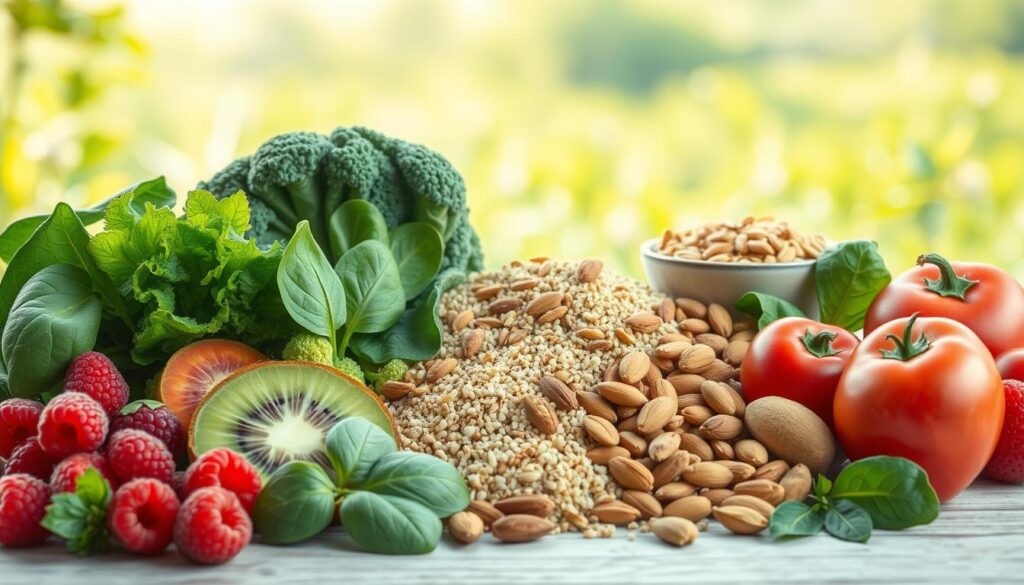Physical Address
304 North Cardinal St.
Dorchester Center, MA 02124
Physical Address
304 North Cardinal St.
Dorchester Center, MA 02124

Surprising fact: your gut hosts trillions of microbes that shape immunity, mood, and metabolism — more influence than many organs.
Digestion begins the moment food touches your mouth. Saliva starts to break starches while muscles move the bite down the esophagus. The stomach and intestines then extract vitamins, minerals, and fluids over several hours.
The gut microbiome ferments fiber and other nutrients into compounds that support digestion and overall health. A diverse community of microbes links to better metabolic and immune outcomes.
This article will show evidence-based foods and simple habits to support your digestive system. Expect practical tips on building plates with plants, whole grains, and protein, plus easy swaps like frozen or no‑salt canned produce. Small, steady changes add up.
Tiny organisms in the gut play an outsized role in metabolism, immune response, and how the body handles stress. Gut health describes the function and balance of the digestive system — the stomach, small intestine, colon — plus the trillions of microbes that live there.
The microbiome — mostly bacteria with some fungi and viruses — helps break down food, makes metabolites, and supports immune regulation of inflammation. A diverse microbial community links to better digestion and metabolic control.
Research now ties gut function to brain signals, mood, and immunity. That means the digestive system works closely with nerves and hormones, and with organs like the pancreas, liver, and gallbladder.
Noticeable changes like bloating or frequent gas can signal your digestive system needs attention. Watch for repeating symptoms that affect daily life. Early detection helps guide simple, effective changes.
Common symptoms include bloating, gas, constipation, diarrhea, and heartburn. A frequently upset stomach may mean your body is struggling to process food or your microbial balance is off.
Antibiotics can lower both harmful and beneficial bacteria, so recovery may take time and targeted food choices. Diets high in ultra‑processed items and added sugar often shift the gut community and worsen GI signs.
High stress and poor sleep change hormone signals that affect digestion. Many people see symptoms flare during busy or sleepless periods.
Simple pantry choices can supply fiber, anti-inflammatory compounds, and healthy fats that keep the gut moving. Rotate a handful each week to diversify what your microbes see.
Ground flax adds omega-3 fats, soluble and insoluble fiber, and antioxidants. Mix a tablespoon into oatmeal or smoothies so the nutrients absorb better and digestion feels smoother.
Use turmeric and ginger in teas, dressings, or sautés. Both have anti-inflammatory compounds; ginger also soothes nausea and can calm an upset stomach.
Legumes bring plant protein and slow-digesting fiber that promotes fullness. Soak beans before cooking to reduce gas and ease gastric transit.
Avocados offer healthy fats and pectin fiber in a creamy, versatile form. Add slices to salads or toast to support steady motility and nutrient absorption.
Oats supply soluble fiber that forms a gentle gel. This can steady digestion, help blood sugar control, and support cholesterol levels.
Canned pumpkin is an easy source of fiber and micronutrients like vitamin K. Stir it into yogurt, soups, or baked goods to boost fiber without extra prep.
Tip: Rotate these foods with colorful vegetables and berries to widen fiber types and the nutrients your gut thrives on.
Small swaps—like brown rice for white—raise daily fiber and widen the nutrients your gut bacteria use. Aim to get more high fiber choices across meals so microbes see a variety of substrates.
Oats, quinoa, brown rice, and whole grain bread add different types of fiber that feed diverse microbes. Make at least half your grain servings whole to boost daily fiber and micronutrients.
Eat a rainbow. Differentvegetablesand fruits contain varying fibers and polyphenols that help improve microbial diversity and nutrient intake.
Beans, lentils, chickpeas, and edamame supply fiber and plantprotein. Cook a batch of lentils or keep rinsed canned beans on hand for quick meals.
Sprinkle nuts or seeds on yogurt and salads to raise fiber and healthy fats. Swap white bread and rice for whole grain bread, quinoa, or brown rice.
“Increase fiber gradually and drink water to reduce gas while your system adapts.”
| Swap | Why | Quick tip |
|---|---|---|
| White rice → Brown rice | More fiber and minerals | Batch cook and freeze portions |
| White bread → Whole grain | More sustained energy | Choose 100% whole grain labels |
| Snack → Nuts/seeds | Fiber, micronutrients | Portion to a small handful |

Everyday fermented choices bring live bacteria to the table and can nudge the microbiome toward greater balance.
How they work: Fermented foods deliver live cultures that may bolster the mix of good bacteria in your gut. That variety can support immune signals and overall health when combined with a varied diet.
Choose plain yogurt or kefir without added sugar. Sweeten with fruit, cinnamon, or vanilla instead. Try a kefir smoothie with banana and blueberries to add prebiotic fiber and boost effects.
These tangy options add texture and live microbes to bowls, sandwiches, or salads. Look for refrigerated jars that list active, live cultures on the label.
Use tempeh as a pan-seared protein and miso in soups or marinades. Both bring flavor and fermented compounds that can diversify your meals.
Kombucha and naturally leavened sourdough are easy ways to add fermented variety. Keep kombucha refrigerated and choose sourdough made from starter cultures.
“Pairing probiotics with prebiotic-rich foods helps the microbes colonize and resist disruption.”
| Item | Serves | Practical tip |
|---|---|---|
| Yogurt / Kefir | Daily | Pick plain, refrigerate, add fruit |
| Kimchi / Sauerkraut | Several times weekly | Use as a condiment to add microbes and flavor |
| Tempeh / Miso | As protein swap | Stir-fry tempeh; dissolve miso off-heat |
| Kombucha / Sourdough | Occasional | Choose refrigerated kombucha; slice sourdough thin |
Note: Product labels should list “live” or “active cultures.” Refrigeration helps preserve viability. Pairing these choices with fiber-rich ingredients can help improve microbial resilience over time.
Prebiotics are types of fiber your body doesn’t digest. Instead, they feed beneficial gut bacteria and may help improve the balance of the microbiome.

Oats and other whole grains make a great base for a prebiotic breakfast. Top cooked oats or quinoa with sliced apples or bananas for texture and taste.
Mashed avocado adds creamy soluble fiber to toast or bowls. These simple swaps deliver fuel that microbes use to make helpful compounds.
Alliums and asparagus contain inulin and related fibers that reach the colon intact. Add raw onions to salads, roast asparagus, or stir garlic into sauces to boost prebiotic intake.
Pair prebiotic-rich items with probiotic sources like yogurt or miso. A yogurt bowl with banana or miso soup with vegetables may help reinforce microbial diversity.
“Rotate different prebiotic fibers each week to give the microbiome varied fuel.”
Small, regular choices — combining prebiotic food with live cultures — support a more stable and diverse gut ecosystem over time.
Certain ingredients can worsen common digestive symptoms in sensitive people. Pay attention to labels and how your body responds after meals. Small changes often reduce discomfort and support microbial balance.
“Sugar‑free” or “calorie‑free” claims often mean artificial sweeteners or sugar alcohols. These can cause bloating, gas, and diarrhea in some individuals, even at low amounts.
“If a product lists erythritol, sorbitol, sucralose, or maltitol, try a small test portion first.”
Regular intake of foods high in saturated and trans fats links to increased gut inflammation. Choose lean proteins and plant proteins like tofu, edamame, quinoa, beans, or hummus instead.
Ultra‑processed snacks and sweets can reduce microbial diversity over time. Swap sweets and packaged treats for whole, minimally processed staples to protect diversity and lower inflammation.
Lactose intolerance often shows up as abdominal pain, gas, and diarrhea after dairy. If symptoms match, try lactose‑free dairy or plant‑based alternatives such as almond, oat, or soy milk.
| Ingredient/Item | Why limit it | Smart swap |
|---|---|---|
| Artificial sweeteners / sugar alcohols | May trigger gas, bloating, diarrhea | Small amounts of fruit, or a little maple syrup |
| Saturated / trans fats | Linked with gut inflammation | Grilled fish, beans, or tofu |
| Ultra‑processed, high‑sugar snacks | Can lower microbial diversity | Whole nuts, fruit, plain yogurt |
| Dairy (if intolerant) | Causes abdominal pain and loose stools | Lactose‑free dairy or plant milks |
Use a visual plate guide to turn good intentions into quick, gut-friendly meals. A simple layout helps you plan portions that support comfortable digestion and steady energy.

Fill half the plate with vegetables and fruits. This boosts fiber variety and vitamins without extra effort.
Reserve one quarter for whole grains or other complex grains to supply steady fuel and prebiotic content.
The remaining quarter is protein. Choose fish, beans, tofu, or lean poultry to support muscle and microbial balance.
Frozen and no-salt-added canned produce keep variety year-round and lower waste. They often match fresh produce in nutrients and cost less.
Quick assemblies make practice easy: grain bowls with roasted vegetables and beans, omelets with greens and fruit, or hearty soups loaded with legumes.
Slow down, take a few deep breaths, and chew thoroughly. These small habits calm the nervous system and improve how food moves through the gut.
Prep a weekend mix of vegetables, grains, and protein so gut-friendly plates require minimal time on busy days.
“Small plate habits—consistent portions, simple prep, and mindful chewing—make lasting changes easier.”
| Plate Component | Why it helps | Quick idea |
|---|---|---|
| Half: Vegetables & Fruits | Fiber, vitamins, varied substrates for microbes | Mixed salad or roasted veg medley |
| Quarter: Whole grains | Slow energy, prebiotic content, steady digestion | Quinoa or brown rice bowl |
| Quarter: Protein | Satiety, repair, supports microbiome balance | Grilled salmon, tempeh, or lentils |
| Frozen / No-salt canned | Budget-friendly, consistent nutrient content | Frozen peas, canned no-salt tomatoes |
Simple routines—consistent sleep, calm breathing, and light activity—help the digestive system run more smoothly. These daily habits support how the digestive tract handles food and how bacteria interact with the body.
High stress and poor sleep disrupt microbial balance and raise GI sensitivity. Aim for 7–8 hours of sleep and add short relaxation breaks to protect mental health and overall health.
Emerging research links better sleep with steadier digestion and fewer symptom flares. Lower stress helps the nervous system send calmer signals to the digestive tract.
Drink water through the day to keep stools soft and support microbial diversity. Studies show higher fluid intake associates with fewer GI infections in people who stay hydrated.
Combine hydration with gentle movement—walking, yoga, or stretching—to stimulate motility. These activities complement fiber from food and help the system move waste efficiently.
Supplements may help if dietary changes fall short. Talk with a clinician to match strains, doses, and goals, since product quality varies and effects are strain-specific.
“People with weakened immunity or serious illness should avoid probiotic supplements unless advised by a clinician.”
Note: ongoing research ties stress reduction and sleep quality to a healthier microbiome. Use lifestyle changes first, and consider supplements only as a targeted next step.
In short, choose everyday ingredients that help bacteria thrive and the digestive tract function better.
Build meals around vegetables, whole grains, legumes, nuts, and seeds to add varied fiber. A high fiber pattern feeds gut bacteria and may lower inflammation.
Add fermented foods like yogurt, kefir, or miso regularly to introduce good bacteria and support balance in the system.
Cut back on ultra‑processed items and added sugar to protect microbial diversity. Track symptoms, make gradual swaps, and get medical advice if issues persist.
Research is evolving, so personalize choices and focus on consistent, plant-forward meals to support gut health over time.